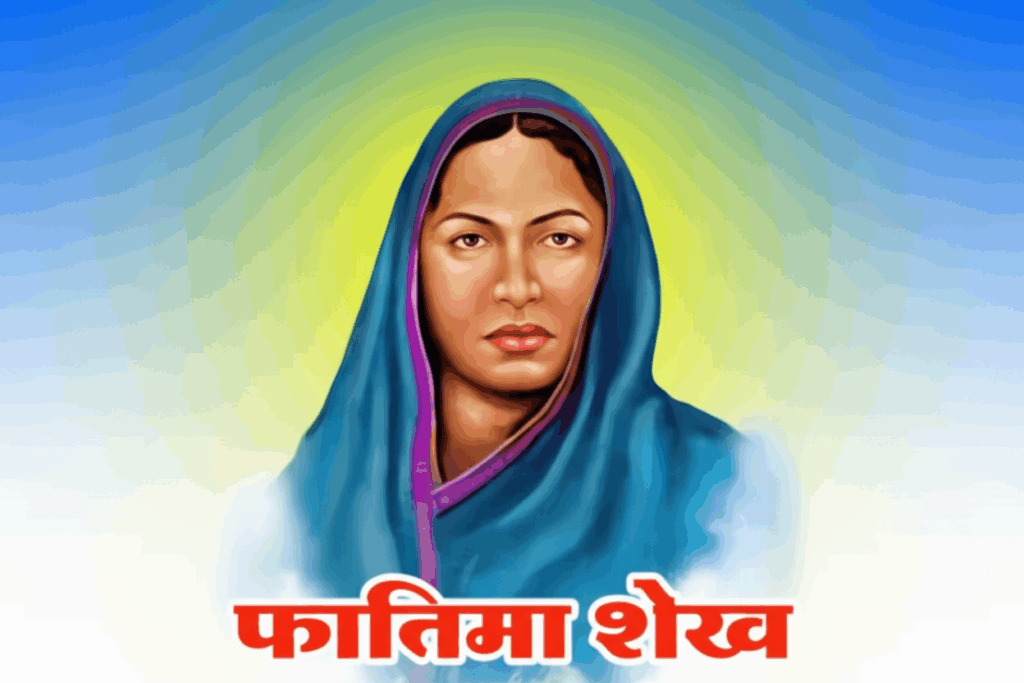She is a beacon of light in Indian history often denied the recognition she deserved in its pages: Fatima Sheikh. In the conservative 19th century, when education for women and Dalits was merely a dream, Fatima Sheikh, along with Jyotiba Phule and Savitribai Phule, brought that dream to reality. She is celebrated as India’s First Muslim Woman Teacher and a great social reformer.
Symbol of Dalit-Muslim Unity: Fatima Sheikh’s Great Contribution to Education
Birth and Early Life
Fatima Sheikh was born on January 9, 1831, in Pune, Maharashtra. Her brother, Usman Sheikh, was a friend of Jyotiba Phule. While concrete information about her demise is scarce, some sources suggest she passed away around October 1900.
In an era marked by extreme caste-based discrimination and gender inequality, Fatima Sheikh, together with her brother Usman Sheikh, chose the path of social reform.

Education and the Journey to Becoming a Teacher
Fatima Sheikh’s contribution to education is invaluable. She underwent Teacher’s Training alongside Savitribai Phule at a missionary school in Ahmednagar. This highlights her profound commitment to education, placing her among the most educated and trained women of her time.
In 1848, when Jyotiba Phule and Savitribai Phule were expelled from the Phule family for teaching Dalit and extremely marginalized girls, Usman Sheikh offered them shelter in his Pune home. It was here, in 1848, that India’s first school for girls, the ‘Native Female School’ (Swadeshi Pustakalaya), was established. Fatima Sheikh began teaching at this school with Savitribai Phule, thus becoming India’s First Muslim Woman Teacher.
Expansion of Teaching Work
Fatima Sheikh’s contribution was not limited to just one school.
- Teaching in Multiple Schools: She taught alongside Savitribai Phule in all five schools opened by Jyotiba Phule in and around Pune.
- Her Own Schools: In 1851, she also established two schools for girls in Mumbai (then Bombay), expanding the reach of her educational mission.
- “Full-Time Teacher”: According to some historians, while Savitribai Phule also engaged in writing alongside teaching, Fatima Sheikh was primarily a ‘full-time teacher’ who dedicated her entire time to instruction.
Great Struggles and Challenges
Fatima Sheikh’s path was never easy. Her and the Phule couple’s social reform work faced intense opposition from the conservative society of the time.
- Social Ostracism: Fatima Sheikh faced social boycott due to her progressive views and advocacy for education.
- Daily Harassment: When Fatima and Savitribai went to school, people would hurl stones, cow dung, and garbage at them, as it was considered unimaginable for women to read and teach then.
- Fighting Conservatism: As a Muslim woman, she had to fight not only for women’s education in general but also against conservative norms within her own community. She bravely taught Dalit and Muslim children together, a revolutionary act for that era.
Despite these challenges, Fatima Sheikh never lost heart and remained steadfast in her mission.
Support and Shelter for the Phule Couple
The most significant and courageous contribution of Fatima Sheikh and her brother, Usman Sheikh, was providing shelter to Jyotiba and Savitribai Phule when their own family had abandoned them.
Proof of Fearlessness: This action by Fatima Sheikh demonstrated her indomitable courage. Offering refuge to a Hindu Dalit couple and actively partnering in their educational mission, all while belonging to a Muslim family, was an act of revolution and unity in the then-prevailing society.
Mention in Literature and History
Despite the scarcity of primary information about Fatima Sheikh, her mention is found in crucial historical documents:
- Savitribai Phule’s Letters: Savitribai Phule mentioned ‘Fatima’ in a letter written to Mahatma Phule in 1856. She praised Fatima Sheikh’s tireless handling of school work, writing that, “Fatima must suffer, but she never complains.” This letter serves as a testament to their close collaboration and Fatima’s diligence.
- Andhra Pradesh Government’s Contribution: Recognizing her historical role, the Andhra Pradesh government included a lesson on her biography and social reform work in its Class 8 curriculum.
Contribution as a Social Reformer
Fatima Sheikh’s life extended beyond that of a teacher; she was an active social reformer.
- Spread of Education: She advanced the objectives of the ‘Satyashodhak Samaj’ (Truth-Seekers’ Society), primarily aimed at providing equal educational opportunities to marginalized people. She went door-to-door to Dalit and minority homes, urging parents to send their children to school.
- Work for Equality: Fatima Sheikh educated not just girls, but also the oppressed and those deemed ‘Shudra’ children, strengthening the foundation of social equality.
- Savitribai Phule’s Pillar of Support: She was a strong ally to Savitribai Phule. When Savitribai was unwell, Fatima Sheikh single-handedly managed the entire school administration. The Phule couple’s educational mission could not have succeeded without her unwavering support.
Through her work, Fatima Sheikh proved the necessity of transcending religious boundaries for education and social change. Her life teaches us that the struggle for social justice and equality is never in vain, even if history is slow to recognize it. Her contribution will remain an inspiration for generations to come.
Google Doodle’s Tribute
In the modern age, Fatima Sheikh’s contribution gained global recognition. On her 191st birth anniversary (January 9, 2022), Google paid tribute by publishing a special ‘Google Doodle’. This testifies to the continued importance of her work and legacy today.
Fatima Sheikh is a true inspiration whose work demonstrated that the fight for education and social justice transcends the boundaries of any religion or caste.
Conclusion: Fatima Sheikh’s Immortal Legacy
Fatima Sheikh’s life is the story of an ordinary Muslim woman who rose to become an extraordinary social reformer. Her contribution deserves more than just recognition as India’s First Muslim Woman Teacher; she was the soul of Savitribai Phule’s educational mission.
In the conservative and casteist society of the 19th century, Fatima Sheikh bravely shattered three major barriers:
- Gender Barrier: A woman leaving her home to teach.
- Religious Barrier: A Muslim woman teaching Dalit and extremely marginalized girls.
- Social Barrier: Facing social exclusion by sheltering the Phule couple.
Fatima Sheikh teaches us that true progress happens when the exploited and deprived communities unite for education and equality. Her brother Usman Sheikh’s act of converting his home into India’s first girls’ school, and Fatima’s resolve to persist despite the opposition, stand as the best examples of social harmony and selfless service.
Today, as we discuss women’s empowerment and inclusive education, Fatima Sheikh’s name emerges from the pages of history to become an inspiration for every citizen. Her legacy reminds us that lighting the lamp of knowledge is the greatest revolution for societal reform.
Fatima Sheikh: An Enduring Legacy and Inspiration
To read more about the revolutionary spirit of Fatima Sheikh in depth, you’ll need to rely primarily on Dalit-Bahujan literature and Research Papers, as her life has been insufficiently documented in mainstream history.
Here are some important sources and books:
1. Books
A few books specifically focusing on Fatima Sheikh (mostly available in Hindi and Marathi) include:
| Book Title (Hindi/English) | Author | Language | Importance |
| The First Muslim Women Teacher of Modern India: Fatima Sheikh | Syed Nasheer Ahmad | English/Hindi translations may be available. | This is one of the foundational and crucial books on Fatima Sheikh, providing research-based insights into various aspects of her life. |
| India’s first Muslim woman teacher – revolutionary Fatima Sheikh | Mohandas Naimishrai | Hindi | This book highlights her struggle and her revolutionary contribution to the movement. |
| Story of Fatima Sheikh (India’s first Muslim teacher) | Anil Gajbhiye | Hindi | This presents her biography in a narrative, easy-to-read format. |
2. Research and Academic Sources
The most reliable information about Fatima Sheikh can be found in references within these larger works:
- ‘Samagra Vangmay’ (Collected Works) of Savitribai Phule and Jyotirao Phule: Fatima Sheikh is mentioned in the letters and writings of the Phule couple, which constitutes the strongest historical evidence of her existence and contribution. Important: Specifically, look for the letters from Savitribai Phule in which she mentions Fatima Sheikh.
- Women Writing in India: 600 B.C. to the Early Twentieth Century (Volume I) | Edited by: Susie Tharu and K. Lalita: This anthology mentions Fatima Sheikh and is one of the earliest academic sources to confirm her existence.
- Research Journals: Academic periodicals like the Journal of Historical Studies and Research have published research articles on her life and work from time to time. You can search for articles such as “India’s Oft-Forgotten Feminist Icon Fatima Sheikh.”
3. Online and Government Sources
- Wikipedia: Fatima Sheikh’s Wikipedia page is a good collection of academic citations and references related to her life.
- Andhra Pradesh Government Textbooks: The Andhra Pradesh government has included a lesson about her in their textbooks, acknowledging her contribution. These lessons can provide simple and accurate information.
- Research-Based Articles from Reputable Media Portals: Following recent debates over Fatima Sheikh’s historical existence, portals like The Wire and ThePrint published in-depth research articles discussing historical evidence (letters, photos).
If you wish to pursue a deep study, try to locate the book by Syed Nasheer Ahmad and the original references related to Fatima Sheikh within the collected works of the Phule couple.




